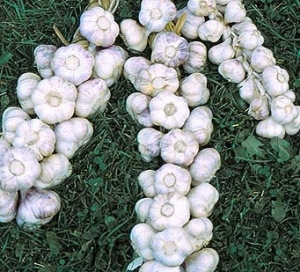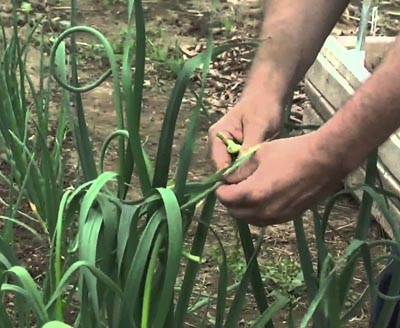Growing Garlic
It’s easier than you think
By Angela Sakran, Fairfax Master Gardener
 Up until now, I’ve avoided growing underground edibles, such as potatoes, onions and, my favorite, garlic. This was simply because I can’t see them growing under the soil, and that bothers me. But there came a time when the urge to grow, pick and cook with my own garlic overtook me; so I set aside my unease about underground edibles and did some research.
Up until now, I’ve avoided growing underground edibles, such as potatoes, onions and, my favorite, garlic. This was simply because I can’t see them growing under the soil, and that bothers me. But there came a time when the urge to grow, pick and cook with my own garlic overtook me; so I set aside my unease about underground edibles and did some research.
Garlic, it turns out, is fairly easy to grow. As with spring-blooming bulbs, the best time to plant garlic is in the fall. The reason? Garlic has a chilling requirement; you plant it in fall and allow the cloves to winter underground. In our area, you can plant garlic from November to early December to foster good root growth and early maturity. That said, you can also plant garlic in springtime, if you incorporate one extra step: To satisfy that chilling requirement, you must store the garlic in a refrigerator for at least eight weeks prior to planting. Then, plant it as early in spring as possible, but no later than March or April, to allow the heads to develop fully.
When selecting a planting site, choose one with good drainage or amend the soil accordingly. Garlic grows best in well-drained garden soil that incorporates a moderate amount of organic matter, such as compost or rotted manure, and offers ample air circulation. The good drainage helps to avoid bulb-rot. (For someone like me, who isn’t comfortable with what I can’t see, this resonated: good drainage means no bulb-rot.) If you don’t have a site with good drainage, consider planting in raised beds.
The type of garlic you sow is an important consideration. You can plant garlic purchased in the grocery store, but sometimes this is treated to prevent the natural growth cycle from occurring. To bypass that disappointment, shop for the garlic you will plant at a local gardening center or online. Look for bulbs that are firm and large-cloved. The larger the clove you plant, the larger the bulb at harvest. Separate cloves from the main bulb only at planting time, as early separation decreases yield. Each unpeeled clove should be planted separately in full sun, set with the tip up, 1 to 2 inches beneath the soil surface, and 4 to 6 inches apart. Rows should be at least 12 inches apart. After planting, mulch the area with organic materials to help minimize fall weeds.
In the spring, in heavier soils, rake back any mulch around the garlic to avoid excess moisture that could cause bulb-rot. Additionally, one to two side dressings of soluble fertilizer in springtime will promote strong, healthy growth. Because of its shallow root system, garlic does not compete well with weeds, so handpick or hoe them.

Removing scapes from garlic plants can increase yields
By early to mid-summer, your garlic will have matured and be ready for harvesting. It’s easy to tell when to harvest. When the garlic is mature, leaf tops will begin to dry, discolor and bend toward the ground. When one-third to one-half of the leaves has died back, loosen the soil and gently pull the plant from the ground. Remove the excess soil, but don’t wash it. Now, your garlic must “cure” or dry. To do this, lay the plants–stalks and all–on a screen, or hang them in bunches for four to six weeks in a well-ventilated room or garage.
In subsequent years, rotate where you plant your garlic, and, never plant garlic where a member of the onion family has grown in the past two years. This is because garlic is susceptible to the same insects and diseases as onions. Remembering these rules–as well as the need to grow garlic in soil that has good drainage, added organic matter, and ample air circulation–and you’ll find that growing garlic isn’t a mystery at all.
References
• Time to Plant Garlic,Tony Bratsch, Virginia Tech Department of Horticulture
• Onions, Garlic and Shallots, Virginia Cooperative Extension, Virginia Tech/Virginia State University,
Publication 426-411
• Growing garlic in home gardens, Carl J. Rosen and Cindy Tong, Extension horticulturalist, University of
Minnesota Extension